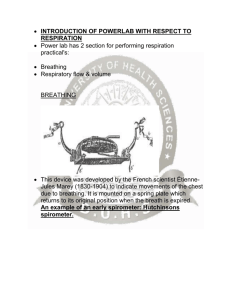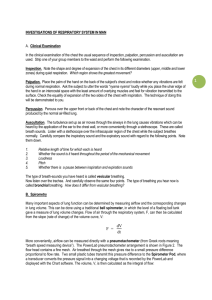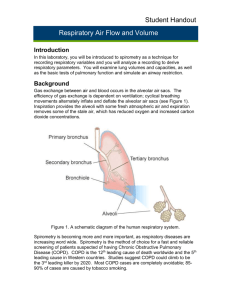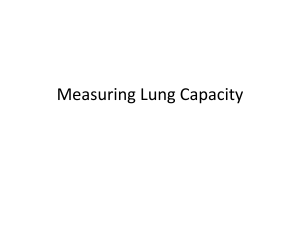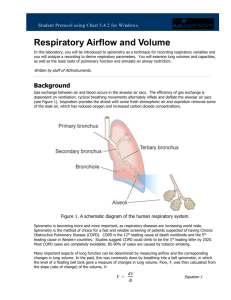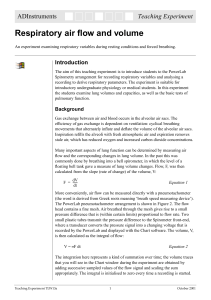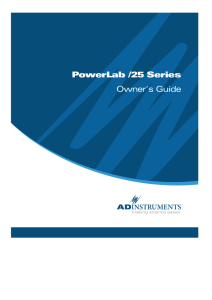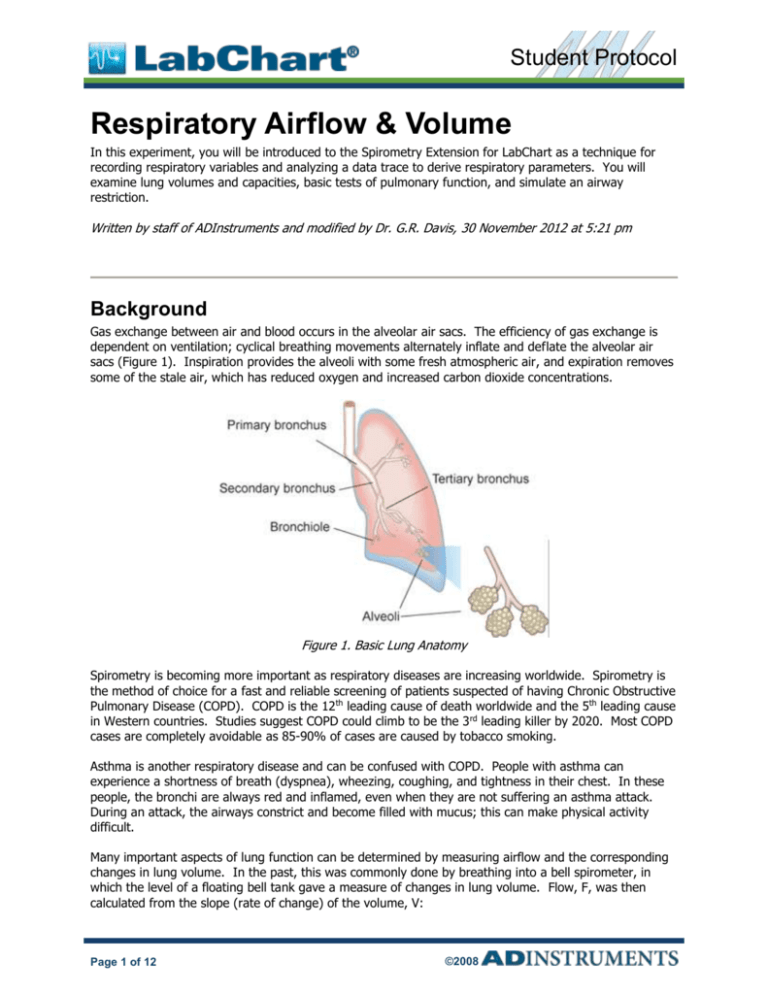
Student Protocol
Respiratory Airflow & Volume
In this experiment, you will be introduced to the Spirometry Extension for LabChart as a technique for
recording respiratory variables and analyzing a data trace to derive respiratory parameters. You will
examine lung volumes and capacities, basic tests of pulmonary function, and simulate an airway
restriction.
Written by staff of ADInstruments and modified by Dr. G.R. Davis, 30 November 2012 at 5:21 pm
Background
Gas exchange between air and blood occurs in the alveolar air sacs. The efficiency of gas exchange is
dependent on ventilation; cyclical breathing movements alternately inflate and deflate the alveolar air
sacs (Figure 1). Inspiration provides the alveoli with some fresh atmospheric air, and expiration removes
some of the stale air, which has reduced oxygen and increased carbon dioxide concentrations.
Figure 1. Basic Lung Anatomy
Spirometry is becoming more important as respiratory diseases are increasing worldwide. Spirometry is
the method of choice for a fast and reliable screening of patients suspected of having Chronic Obstructive
Pulmonary Disease (COPD). COPD is the 12th leading cause of death worldwide and the 5th leading cause
in Western countries. Studies suggest COPD could climb to be the 3 rd leading killer by 2020. Most COPD
cases are completely avoidable as 85-90% of cases are caused by tobacco smoking.
Asthma is another respiratory disease and can be confused with COPD. People with asthma can
experience a shortness of breath (dyspnea), wheezing, coughing, and tightness in their chest. In these
people, the bronchi are always red and inflamed, even when they are not suffering an asthma attack.
During an attack, the airways constrict and become filled with mucus; this can make physical activity
difficult.
Many important aspects of lung function can be determined by measuring airflow and the corresponding
changes in lung volume. In the past, this was commonly done by breathing into a bell spirometer, in
which the level of a floating bell tank gave a measure of changes in lung volume. Flow, F, was then
calculated from the slope (rate of change) of the volume, V:
Page 1 of 12
©2008
Respiratory Airflow & Volume
Student Protocol
F =
dV
dt
More conveniently, airflow can be measured directly with a pneumotachometer (from Greek roots
meaning “breath speed measuring device”). The PowerLab pneumotachometer is shown in Figure 2.
Figure 2. The PowerLab Pneumotachometer
Several types of flow measuring devices are available and each type has advantages and disadvantages.
The flow head you will use today is a “Lilly” type that measures the difference in pressure either side of a
mesh membrane with known resistance. This resistance gives rise to a small pressure difference
proportional to flow rate. Two small plastic tubes transmit this pressure difference to the Spirometer
Pod, where a transducer converts the pressure signal into a changing voltage that is recorded by the
PowerLab and displayed in LabChart. The volume, V, is then calculated as the integral of flow:
V=
F dt
This integration represents a summation over time; the volume traces you will see in LabChart during the
experiment are obtained by adding successive sampled values of the flow signal and scaling the sum
appropriately. The integral is initialized
to zero every time a recording is started.
A complication in the volume measurement is caused by the difference between ambient temperature
and the air exhaled from the lungs, which is at body temperature. Gas expands with warming; therefore,
if the ambient temperature is cooler than body temperature, you will breathe out a larger volume of air
because the air is warmed in the body. The volume of air expired can also be increased by
humidification, which happens in the alveoli. Since you breathe out a larger volume of air than you
breathe in, the volume data trace drifts in the expiratory direction. Computer software corrections used
in the Spirometry Extension can reduce drift but cannot eliminate it.
Spirometry allows many components of pulmonary function to be visualized, measured, and calculated
(Figure 3). Respiration consists of repeated cycles of inspiration followed by expiration. During the
respiratory cycle, a volume of air is drawn into and then expired from the lungs; this volume is the tidal
volume (VT). In normal ventilation, the breathing frequency (ƒ) is approximately 15 respiratory cycles
per minute. This value varies with the level of activity. The product of ƒ and VT is the expired minute
volume (VE), the amount of air exhaled in one minute of breathing. This parameter also changes
according to the level of activity. Even when a person exhales completely, there is still air left in the
lungs. This leftover air is the residual volume (RV), which cannot be measured by spirometry.
Page 2 of 12
©2008
Respiratory Airflow & Volume
Student Protocol
Figure 3. Lung Volumes and Capacities
Terms with Which You Should Familiarize Yourself:
Term
Abbreviation/
Symbol
Respiratory Rate
RR
Expired Minute Volume
VE = RR x VT
Lung Volumes
Tidal Volume
VT
Inspiratory Reserve Volume
IRV
Expiratory Reserve Volume
ERV
Residual Volume
RV (predicted)
Lung Capacities
Inspiratory Capacity
IC = VT + IRV
Expiratory Capacity
EC = VT + ERV
Vital Capacity
VC = IRV + ERV + VT
Functional Residual Capacity
FRC = ERV + RV
Total Lung Capacity
TLC = VC + RV
Pulmonary Function Tests
Peak Inspiratory Flow
PIF
Peak Expiratory Flow
PEF
Forced Vital Capacity
FVC
Forced Expired Volume in One Second
FEV1
%FVC Expired in One Second
FEV1 / FVC x 100
Required Equipment
LabChart software with Spirometry Extension
PowerLab Data Acquisition Unit
Spirometer Pod
Respiratory Flow Head (1000 L/min) with connection tubes
Clean-bore Tubing & Tubing Adapter
Disposable Filters
Page 3 of 12
©2008
Units
Breaths/min (BPM)
L/min
L
L
L
L
L
L
L
L
L
L/min
L/min
L
L
%
Respiratory Airflow & Volume
Student Protocol
Reusable Mouthpieces
Nose Clips
Tape measure or wall chart for measuring height
Reading material
Medical tape
Sharpened pencil
Procedure
If you are suffering from a respiratory infection, do not volunteer for this experiment.
Equipment Setup
1. Make sure the PowerLab is turned on and LabChart is running.
2. The Spirometer Pod is connected to Input 1 on the front panel of the PowerLab (Figure 4). Turn on
the PowerLab.
Note: Since the Spirometer Pod is sensitive to temperature and tends to drift during warm-up, it is
recommended the PowerLab (and therefore the Spirometer Pod) is turned on for at least five minutes
before use. To prevent temperature drift, place the Spirometer Pod in a shelf or beside the PowerLab,
away from the PowerLab power supply to avoid heating.
Figure 4. Equipment Setup for PowerLab 26T
3. Connect the two plastic tubes from the Respiratory Flow Head to the short pipes on the back of the
Spirometer Pod. Attach Clean-bore Tubing, a Filter, and a Mouthpiece to the Flow Head (Figure 4).
4. Turn OFF and collapse Channels 3-8.
5. Make the following settings: Sampling rate: 100/s, View: 10:1 compression. Channel 1 should be
“on” and Channel 2 should be “off.” Range for Channel 1 = 500 mV; set the Low Pass to 10
Hz; then select Zero. Input setting = Spirometer Pod. In the Channels Settings under the Setup
Menu, retitle Channel 1 to Flow and Channel 2 to Volume.
Page 4 of 12
©2008
Respiratory Airflow & Volume
Student Protocol
Note: A clean Mouthpiece and Filter should be supplied for each volunteer. The Mouthpiece can be
cleaned between uses by soaking it in boiling water or a suitable disinfectant.
Exercise 1: Familiarize Yourself with the Equipment
In this exercise, you will learn the principles of spirometry and how integration of the flow signal gives a
volume.
Calibrating the Spirometer Pod
The Spirometer Pod must be calibrated before starting this exercise. The Flow Head must be left
undisturbed on the table during the zeroing process.
1. Open LabChart
2. Select Spirometer Pod from the Channel 1 Channel Function pop-up menu. Make sure the Range
is 500 mV. When the value remains at 0.0 mV, have the volunteer breathe out gently through the
Flow Head, and observe the signal (Figure 5). If the signal shows a downward deflection (it is
negative), you can return to the Chart View. If the signal deflects upward, you need to invert it.
Click the Invert checkbox once.
Figure 5. Spirometer Pod Dialog with Downward Deflection
Using the Equipment
1. Have the volunteer put the Mouthpiece in their mouth and hold the Flow Head carefully with both
hands. The two plastic tubes should be pointing upward.
2. Put the nose clip on the volunteer’s nose. This ensures that all air breathed passes through the
Mouthpiece, Filter, and Flow Head (Figure 6).
3. After the volunteer becomes accustomed to the apparatus and begins breathing normally, you are
ready to begin.
Page 5 of 12
©2008
Respiratory Airflow & Volume
Student Protocol
Figure 6. Proper Positioning of the Flow Head
4. Start recording. Have the volunteer perform a full expiration and then breathe normally. Record the
volunteer’s tidal breathing for one minute. At the end of one minute, have the volunteer perform
another full expiration. Observe the data being recorded in the “Flow” channel. Stop recording.
The volunteer can stop breathing through the Flow Head and can remove the Nose Clip.
Setting Up the Spirometry Extension
The Spirometry Extension processes the raw voltage signal from the Spirometer Pod, applies a volume
correction factor to improve accuracy, and displays calibrated Flow (L/s) and Volume (L) traces. It takes
over from Units Conversion. The trace you recorded in this exercise will provide reference points for the
Spirometry Extension that allows it to calculate and perform corrections on the trace.
1. Drag across the Time axis at the bottom of the Chart View to select the data you recorded.
Select Spirometry Flow from the Channel 1 Channel Function pop-up menu. Make sure the
settings are the same as those in Figure 7. Note: your screen may not appear exactly as Figure 7
due to updates in the software that are provided from time to time. In any case, no changes are
needed.
Figure 7. Spirometry Flow Dialog
2. Select Spirometry Volume from the Channel 2 Channel Function pop-up menu. If your
screen asks, click the Apply Volume Correction checkbox to turn it on. Then select Apply to allow
the extension to use the volume correction ratio that is has calculated from your data (Figure 8;
Page 6 of 12
©2008
Respiratory Airflow & Volume
Student Protocol
again your computer screen may not be exactly like Figure 8). The Chart View should now appear
with calculated volume data on Channel 2.
Figure 8. Spirometry Volume Dialog
3. Select Set Scale from the Scale pop-up menu in the Amplitude axis (arrow in the upper left margin)
for the “Flow” channel. Make the top value 15 L/s and the bottom value -15 L/s.
Exercise 2: Lung Volumes and Capacities and Pulmonary Function Test
In this exercise, you will examine the respiratory cycle and measure changes in flow and volume.
1. Zero the Spirometer Pod again, using the same procedure as before (Spirometer pod under Channel
1 and then Zero). Remember to leave the Flow Head undisturbed during the process. Volunteers
are not breathing in the apparatus for the zeroing procedure.
2. Have the volunteer face away from the monitor and read while breathing through the spirometer
without the nose clip. Reading will distract the volunteer and prevent the volunteer from consciously
controlling their breathing during the exercise.
3. When ready, Start recording. After two seconds, have the volunteer install the Nose Clip and
breathe normally into the Flow Head. Record normal tidal breathing for one minute.
4. After the tidal breathing period (at the end of a normal tidal expiration), ask the volunteer to
inhale as deeply as possible and then exhale as deeply and as quickly as possible.
Afterwards, allow the volunteer to return to normal tidal breathing for at least 7 breaths.
5. After about 7 normal breaths, ask the volunteer to inhale as deeply as possible and then exhale
as deeply and quickly as possible. You have now recorded data that will allow you to measure
and calculate lung volumes and capacities.
6. Stop the recording.
7. Click Autoscale from the popup menu in the Volume axis (upper left corner of Channel 2).
8. The volunteer can remove the nose clip and discontinue breathing through the flow head. Your now
ready to measure RR, Vt, IRV, ERV, VC, FEV1.0 and calculate FEV1.0/VC.
Page 7 of 12
©2008
Respiratory Airflow & Volume
Student Protocol
Based on the large breaths your volunteer made, you will measure parameters of forced expiration that
are used in evaluating pulmonary function. Note that the Spirometry Extension is not intended for clinical
evaluation of lung function but can be used as an approximation for teaching purposes, so don’t be
alarmed if your Vt is substantially different from 500 ml.
Figure 9. Sample Data of Forced Breaths
Analysis
For measuring lung volumes and capacities, you can ignore the flow values in Channel 1 and make all
your measurements from Channel 2.
Lung Volumes and Capacities
1. Examine the normal tidal breathing data in the Chart View, and Autoscale, if necessary. Calculate
how many breaths there are in a one-minute period (BPM). Record RR on your lab handout.
Determine the volume of a single tidal inspiration by placing the Marker at the start of a normal tidal
inspiration. Place the Waveform Cursor at the peak (Figure 10). The value shown in the
Range/Amplitude display for Channel 2 is the tidal volume (V T) for that breath. Record this value in
hour lab handout.
Page 8 of 12
©2008
Respiratory Airflow & Volume
Student Protocol
Figure 10. Proper Placement of Marker and Waveform Cursor
2. Use the values for tidal volume and the number of breaths observed over a one minute period to
calculate the minute ventilation (V). Use the following equation:
V = RR x VT
(L/min)
3. Use the marker and cursor to determine the inspiratory reserve volume (IRV) (Figure 11) and
expiratory reserve volume (ERV) (Figure 12).
Note: The Marker should be placed at the peak of a normal tidal inspiration for IRV, and it should be
placed at the start of a normal tidal inspiration (trough) for ERV.
Page 9 of 12
©2008
Respiratory Airflow & Volume
Student Protocol
Figure 11. Positioning of Marker and Waveform Cursor to Measure IRV
Figure 12. Positioning of Marker and Waveform Cursor to Measure ERV
1. To measure the vital capacity (VC), place the Marker on the peak inhalation of “Volume,” and
move the Waveform Cursor to the maximal expiration (Figure 14). Read off the result from the
Range/Amplitude display, disregarding the delta symbol and negative sign.
Page 10 of 12
©2008
Respiratory Airflow & Volume
Student Protocol
2. Return the Marker to its box. To measure forced expired volume in one second (FEV1), place
the Marker on the peak of the volume data trace, move the Waveform Cursor to a time 1.0 s from
the peak, and read off the volume value. If you find it hard to adjust the mouse position with
enough precision, a time value anywhere from 0.96 s to 1.04 s gives enough accuracy. Disregard the
delta symbol and negative sign.
3. Calculate the percentage ratio of FEV1 to VC using the following equation:
(FEV1 / VC) x 100
(%)
4. Record your values your lab handout.
5. Be ready to call share your data with the class as all groups conclude these spirometry tests.
Appendix: Vital Capacities in Healthy Individuals1
Height (cm)
Table 1. Predicted Vital Capacities for Males
Height (cm)
1
These tables are based on The Johns Hopkins Pulmonary Function Laboratory equations for pulmonary function.
http://www/hopkinsmedicine.org/pftlab/predeqns.html/
Page 11 of 12
©2008
Respiratory Airflow & Volume
Student Protocol
Table 2. Predicted Vital Capacities for Females
Copyright © 2008 ADInstruments Pty Ltd. All rights reserved.
PowerLab® and LabChart® are registered trademarks of ADInstruments Pty Ltd. The names of specific recording units, such as
PowerLab 8/30, are trademarks of ADInstruments Pty Ltd. Chart and Scope (application programs) are trademarks of
ADInstruments Pty Ltd.
www.ADInstruments.com
Page 12 of 12
©2008


